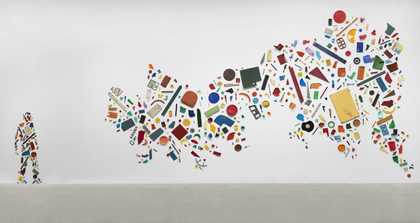
Tony Cragg
Britain Seen from the North (1981)
Tate
When it comes to objects made of plastic in museum collections, the story is entirely different. Plastics can actually be very vulnerable – think of the old, yellowed, or brittle plastic toys you may have seen in the attic. When we try to preserve a plastic object for future generations, we are often keeping it for a much longer period than its commercial producer intended us to. These weakened plastics – be they a part of an artwork or historical object – can be very sensitive to the cleaning that may become necessary to remove deposited soiling and general grime. In addition, various materials used in plastic manufacture (known as exudates) can separate out from the plastic formulation over time and make its surface sticky or powdery.
Many of the solvents and other materials typically used during surface cleaning of non-plastic objects can severely damage the surface of a plastic object. If you’ve ever tried removing a sticky price-label from a plastic object using acetone or rubbing alcohol (isopropyl alcohol), you may have noticed the surface becoming scratched, or becoming white and blanched. This type of damage, even if very minute, is unacceptable for our museum collections. To overcome this problem, museum researchers work to find new and tailored methods for cleaning plastic objects that are safe.
For his sculpture Construction in Space with Crystalline Centre 1939–40, Naum Gabo used an early man-made plastic – cellulose acetate, prepared by chemically modifying naturally derived cellulose – and poly(methyl methacrylate), also known as PMMA or Perspex – a completely synthetic polymer. Cellulose acetate fell out of favour with the artist due to its inherent instability (note the slightly yellowed look of the central diamond elements) relative to new, synthetic plastics. Unfortunately, even Perspex can degrade over time and its smooth and glassy surface can be easy to abrade.
Besides using plastics and resins to create sculptural objects, modern and contemporary artists have also largely adopted synthetic polymer paints such as acrylic emulsions for both paintings and painted objects. Just like plastic objects, the main components of these paints are synthetic polymers – long chains of identical, repeating small molecules. When the paint dries, the polymers cover the surface and fuse together to form a smooth, solid paint-film; and just like plastic objects in museum collections, synthetic polymer paints also pose specific problems related to surface cleaning. Because they are not very stiff at room temperature, dust that settles on their surface can become ingrained into the paint and become very difficult to remove safely, and without changing important aesthetic qualities. Additionally, these types of paint can be sensitive to many cleaning solvents and methods.
Initial research into cleaning strategies for modern and contemporary art materials has already been started through projects such as POPART (Preservation of Plastic Artefacts in Museum Collections), TAAMPP (Tate AXA Art Modern Paint Project), an ongoing collaboration between Tate, the Getty Conservation Institute and The Dow Chemical Company, CAPS workshops (Cleaning Acrylic Paint Surfaces), and numerous independent studies at museums and academic laboratories. Last summer, a new, multinational, large-scale project was initiated to introduce advances developed in nano-material science to some of the challenges posed by modern and contemporary works of art. Through the NANORESTART project, research scientists and conservators at Tate are working in collaboration with many of our colleagues throughout Europe and further afield, to find solutions to the cleaning and other preservation problems associated with plastic objects and synthetic polymer paints.
The NANORESTART project consortium comprises 27 museums, academic institutions, private conservators and private companies working together to find new methods for the conservation and preservation of contemporary art. The core team at Tate includes: Bronwyn Ormsby, Principal Conservation Scientist; Lora Angelova, Conservation Science Researcher, NANORESTART; Pip Laurenson, Head of Collection Care Research; John McNeill, Collection Care Research Manager; Rachel Barker, Painting Conservator; Tamar Maor, Sculpture Conservator; Gates Sofer, Sculpture Conservator and Katey Twitchett-Young, Assistant Painting Conservator.
Along with testing and evaluating novel cleaning systems like microemulsions and gels at Tate, other teams involved in NANORESTART are working on ways of stabilising deteriorating artworks, removing unwanted (modern) materials such as graffiti from heritage objects, and finding coating methods to protect artworks in museums and outdoors. The research and labour is divided amongst the project members, so that each can contribute through their primary speciality. The lead partner at the CSGI Research Centre for Colloid and Surface Science in Florence, Italy will provide a variety of nano-structured liquids and gels which they have researched and determined to be potentially suitable cleaning agents for plastics or synthetic polymer paints. At Tate, we are working with an expert team of scientists and conservators to evaluate these systems on mock-samples, and, potentially, on artworks identified as requiring surface cleaning treatments within Tate’s collection. The aim is not only to observe how the new methods function in the ‘real world’ conservation studio, but also to evaluate them relative to cleaning strategies and materials already used by conservators.
We are soon due to receive the first batch of materials from Florence. In preparation, the Tate NANORESTART team have been busy writing a state-of-the-art report on current practice, meeting with curators and conservators, and investigating artworks that could benefit from being part of the project. Suggestions were made for artworks in different categories: synthetic polymer paintings, plastic objects, painted objects, paintings on plastic, and so on. From each of these lists, four to five pieces were selected. Our current focus is on narrowing down the ‘case-study’ candidates – how do we pick just three from the fifteen works on the shortlist?
Lora Angelova, Bronwyn Ormsby
May 2016

